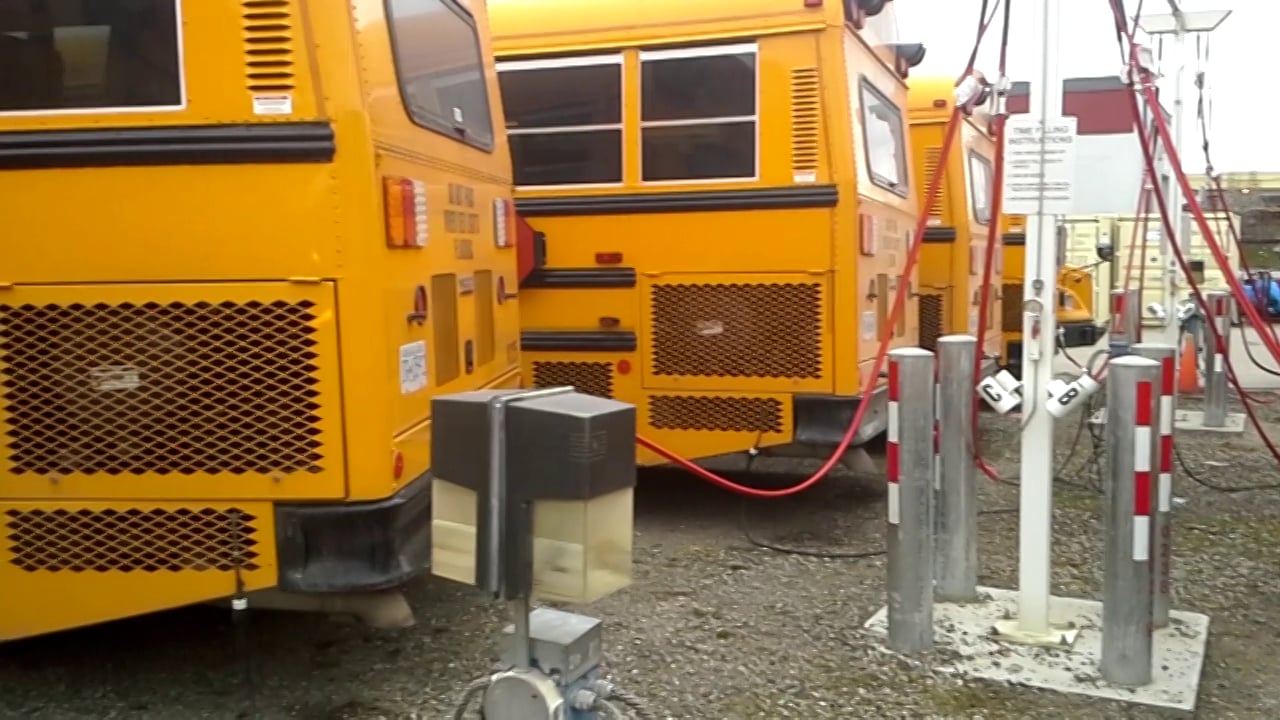The video below is one of the mechanics from the Kelowna school district giving us a tour of their natural gas infrastructure. They have 16 buses running on natural gas and so far they are happy with them.
About Cummins Natural Gas Engines
When we stopped in to the Kelowna school bus garage one of the mechanics was working on one of their natural gas engines installed in a Thomas HDX Pusher bus. It was interesting to see the infrastructure and how much work it was to get this operation going. They have several buses on natural gas and we hung out for a while and asked Terry to run through some of the procedures required when operating these buses.
They have a fast fill and a slow fill system. The fast fill take about 15 minutes while the slow fill which you saw in the video takes a couple of hours. The drivers come in after a run and just hook up and the system is filled up ready for the next run. These natural gas buses can run 400 kilometres (240 miles) on a fill so their range is limited.
Cummins Natural Gas Engine Information
Cummins began research and development into alternative fuels back in 1988. Now there are over 34,000 natural gas engines world wide. The first thing I thought about was the clean emissions compared to fossil fuel diesel engines that require complex components to meet EPA emission standards.
Benefits of Running Natural Gas Engines
1. Extremely low emissions
2. High torque and fuel efficiency
3. Economic advantages down the road
4. Engine noise is reduced
5. Passenger and driver comfort with healthier exhaust emissions
The Cummins natural gas engine starts at 150 horsepower and runs up to 400 HP meetsing or exceeding EPA (environmental protection agency), CARB (California air resources board) and EURO emission standards. This is a huge advantage because of the demand for lower emissions which puts a lot of pressure on diesel engine manufacturers.
{“preview_thumbnail”:”/sites/default/files/styles/video_embed_wysiwyg_preview/public/video_thumbnails/s4nmV2gZcAo.jpg?itok=KoNTi9aX”,”video_url”:”https://www.youtube.com/watch?v=s4nmV2gZcAo”,”settings”:{“responsive”:true,”width”:”854″,”height”:”480″,”autoplay”:false},”settings_summary”:[“Embedded Video (Responsive).”]}
The Cummins ISL G 8.9 Litre Natural Gas Engine
This is the Cummins model found in the Thomas HDX Pusher school bus and was first developed in 2007. It has 1000 lb ft of torque and can run on compressed natural gas, liquid natural gas or renewable natural gas (biomethane).
Fuel enters the engine manifold and is regulated to maintain a steady flow through the mixer. Fuel flow, pressures and temperatures are controlled by various sensors on the engine. Charge air enters the intake system controlled by an electronic throttle that closely controls air flow.
Air flow, EGR and fuel are combined in the mixer where they are delivered to the power cylinder for combustion to take place. Combustion is controlled by 6 high voltage ignition coils, a control module and spark plugs. There are no high energy wires to the plugs they have been replaced with ignition extensions from the coils so the only replacement parts are the spark plugs. The ECM on the ISL G is compatible with Insite Lite software so there is no need for special diagnostic software for CNG engines.
The only difference between and ISL G and a ISL 9 (diesel) on the exhaust side of the engine is the turbocharger. The ISL G uses a wastegate turbo while the ISL 9 uses the VGT (variable geometry turbocharger). Both turbos work very well on all the applications we have in our fleet.
I think this technology is amazing and once it has been totally absorbed by the transportation industry hopefully the price will drop in all areas related to running a fleet of natural gas school buses, class 8 trucks and mid range vehicles. If you nave a comment or even better have experience running natural gas vehicles please leave a comment.







